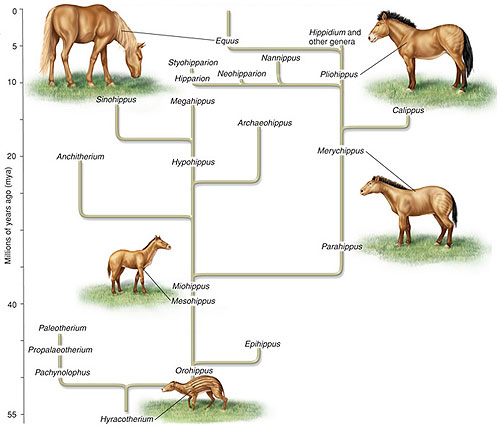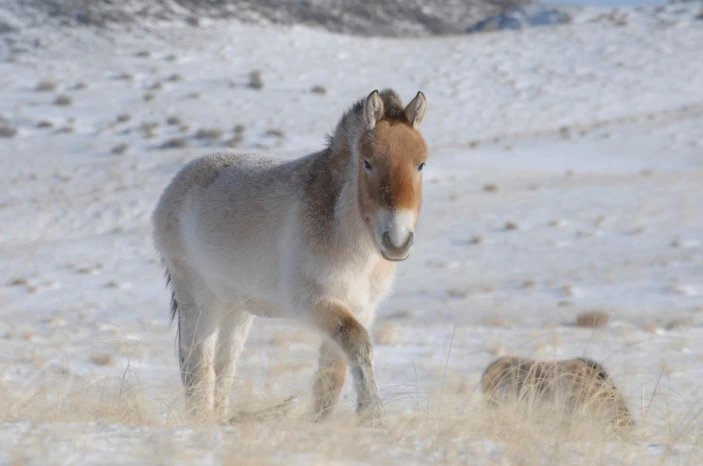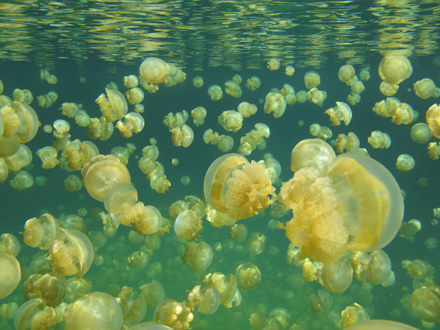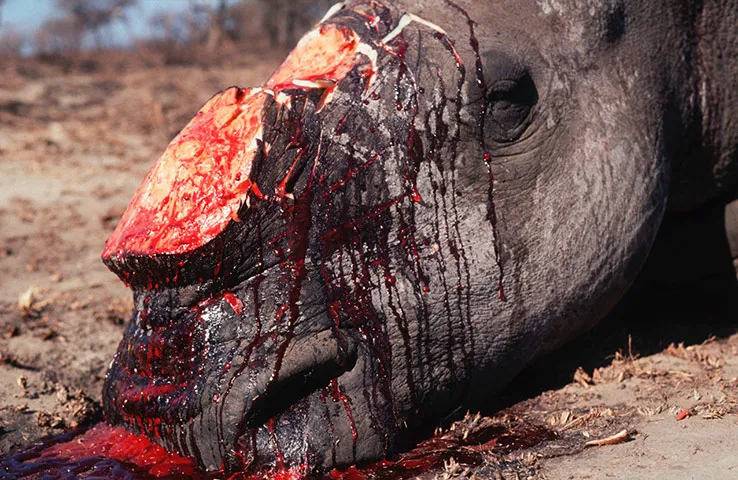
Something nasty is attacking our honey bees.
If you believe a benevolent, loving god created Earth and all the creatures on it for mankind, then you have to be able to explain what's going on here and how it's all to the good.
First a brief outline of what bees do and why they are important to us and the world we live in, apart from providing us with honey. To understand this we need to go back to a time before there were flowering plants and before there was nectar out of which bees could make honey or pollen from which they make the wax to build their honeycomb with.
We need to go back to a time when the most advanced plants were the ferns which dominated the
Carboniferous forests as large tree-ferns. Ferns, along with their more primitive ancestors, the mosses and liverworts do not produce flowers or pollen; instead they produce 'male' and 'female' gamete which depend on the 'male' gametes or sperms (yes, some plants have sperm too) being motile (i.e. able to swim with a flagellum) and finding a 'female' gamete with which to unite, rather like the system used by most higher animals. This means that ferns do best in a moist environment where the motile gamete has moisture to swim in, tied as it still is to the water in which green plants first evolved, with an aquatic form of locomotion.

This requirement to live in moist conditions obviously restricted the range of mosses, liverworts and ferns and made much of the planet inaccessible to them. However, there was a solution available in the form of the very many arthropods - insects, etc, which had colonised the land early on and had proliferated in the hot, moist, oxygen-rich conditions which prevailed in the Carboniferous Era. Clearly, anything which helped a fern sperm find a fern egg, and especially if this worked in dry conditions, would help ferns colonise new niches and would help ensure their success. So, something which attracted insects to crawl over the reproductive structures, picking up sperm on its body and transferring it to the egg would produce more ferns, and what better to do that with than a sugar-rich secretion which the insects were going to actively seek out?
So the symbiotic link between some insects and some plants was probably established which pushed the plants into producing more attractive reproductive structures at the cost of losing some of the pollen as food as well as supplying the sugars in the nectar in return for greater breeding success and being able to move into a whole range of new niches.
And so the class of flowering plants we call the
angiosperms evolved and diversified into the vast number of different species we have today in which the motile male sperms have become passive pollen grains, and so a whole variety of insects species co-evolved, most, but not all of them, as flying insects like the bees.
This process has produced a complex system of mutual interdependence in a process so typical of mindless, unplanned, undirected evolution which can so specialise a species that it only takes a small change to put it into extinction mode. This is one reason why 99% of all species which ever existed are extinct.
Now very many plants are dependent on bees to be pollinated, some of them important crops to humans who have themselves co-evolved dependent on plants that are dependent on bees. Without bees, there will not be a next generation of these crops unless we adopt the hugely expensive and labour intensive method of hand pollination we now use for very careful plant breeding.
So, if you believe in an intelligently designed world, you're probably marvelling at the wonderful system which this has provided for us, though you may have had to find a reason to dismiss the evolutionary process I described as having produced it. Asked for evidence for your creator god you will point to 'everything'; you will point to our crops, to bees and flowers and to nature but for some reason you only ever point to the good, the positive and the beneficial.
Now you have to explain something else.

You have to explain a little mite, the
Varroa destructor mite to be precise.
V. destructor is busy wiping out honey bee colonies, apparently for no other reason than to produce more
V. destructor mites. Not for humans, or bees, or flowering plants but for
V. destructor. It's almost as though an intelligent designer has designed a system because it loves
V.destructor mites. That's if you believe in intelligent design, that is.
You see, back in the Carboniferous, other arthropods, including the arachnids and their close relatives the mites were also evolving by a process which exploits the potential of new niches as they arise and become accessible. The mites evolved out of, probably, sap-sucking arthropods which learned to suck not plants but animals. Some of them were later to evolved to be parasites on mammals, such as tics; some evolved to be the normally harmless little mites that live in your eyelash follicles (yes yours!) and some of them evolved to suck the body fluids from insects, especially those which live in crowded colonies like bees do.

But that's not the worst of it. Bees could possibly survive the need to feed a few mites as well as themselves but what they can't survive is an even nastier little thing.
V. destructor is host to an RNA virus which it almost seems to be designed to pass on to its victims. It causes deformity in bees wings so they can't fly. Other viruses they carry harm bees in other ways. Basically, a hive of bees which becomes infested with
V. destructor has been given a death sentence unless drastic action is taken, but often it is discovered only when the colony collapses and dies.
Without honey bees many of our crops, as well as many wild plants on which other species and other ecosystems depend, will fail. The
Varroa mite has pushed entire ecosystems to the edge of an extinction precipice, and, given the mindlessness of evolution, it is perfectly capable of going over the cliff and taking everything with it. If they go over the edge, the effects will be catastrophic not just for humans for but for much of the planet. The planet, of course, will recover and life will go on as though nothing has happened. New species will evolve and move into vacant niches and life will continue, leaving only vague fossil records that anything significant happened. But no species has a guaranteed right to be involved in its future. The future does not care whether we are there or not. It's up to us to ensure we are.
So, if you are an intelligent design proponent you can't escape the
Varroa mite. You
have to explain why it was designed and how it fits into your intelligently designed universe; designed as you believe by a benevolent god because it loves us. Regrettably, your inability to let go of that cosy simplistic answer may prevent us taking responsibility for our own continued existence and so may ensure we never do.
ShareTwitter
|
StumbleUpon
|
Reddit
 |














